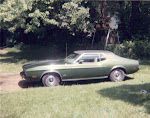The Normal Police Department’s 2008 Annual Report gives the reader the view of police work from the officers’ perspective and shows a very proactive approach to keeping Normal safe. The report is divided into summaries by shift and summaries by division/unit. It’s interesting that each of the four shifts (7-3, 3-11, 11-7, and 6-4) focuses on somewhat different situations, but it makes sense because people engage in different activities, depending on time of day or night.
The Traffic Unit is probably the one unit that many citizens are familiar with (and grumble about). Yes, there were many (over 2,000) citations for speeding in 2008, as well as (fewer) citations for school zone, school bus stop arm, seat belt, and construction zone violations. It’s really all about safety. Other units that are perhaps less familiar are the Proactive Crimes Unit, the Emergency Response Unit, and the Canine Unit. In case you’re interested, the two K-9 partners are “Gunner” and “Rico.” In addition to participating in demonstrations to various organizations, this unit performed 289 vehicle searches, had 204 “positive alerts,” and seized 3,987 grams of cannabis in 2008. And on the subject of drugs, the Vice Unit seized a lot of drugs (including mushrooms; what is this, the 60s?), quite a bit of cash, some guns, and some pipe bombs (well, they didn’t “seize” the bombs, they had them destroyed by the SOS bomb squad).
The Criminal Investigations Division looked into financial crimes, juvenile crimes, domestic violence, and general investigations (theft, burglary, robbery, sexual assault). The police working these cases did not just respond to crimes committed, but also provided follow-up help for those involved, such as helping financial crime victims repair their credit history, providing visits and phone calls to domestic violence victims, and working with other agencies in cases involving juveniles.
Some behind-the-scenes work that is crucial for the department is that of the evidence technicians and the crime analyst. The evidence technicians processed crime scenes and collected evidence (and there are way too many TV shows about this job). The crime analyst gathered and analyzed information about crimes and criminal offenders, and provided reports to officers.
The NPD also worked to keep young people safe and to educate them about safety through the School Resource Officer program and the Elementary Health and Safety Education program. A new program started in 2008 to help young people who are “at risk” of juvenile delinquency: the Youth Intervention Program. This program only just started in August, but by the end of the year, 17 young people participated in the program (out of 71 who were referred). Hopefully, word will get around about successful interventions and more will participate.
Other activities that the NPD is involved in include: the Minority and Police Partnership (M.A.P.P) to improve relations between the minority and law enforcement communities, crash analysis (accidents decreased slightly in 2008 but there were no fatal accidents in Normal; the intersection of College Ave. and Veterans Pkwy. had the most accidents), the Summer Youth Program, the Neighborhood Watch Program (there were 48 watch groups in Normal), the Crime Free Multi-Housing Program, and the Citizens Police Academy. The NPD participated in ongoing training (12,311 hours of training in 2008), received its fourth reaccreditation award, and recognized a number of officers for various awards in 2008. And the Policemen’s Benevolent & Protective Association Normal Unit #22 was very active in local fund-raisers and in providing for less fortunate families in Normal.
The report includes a chart of crime trends. I won’t report all of the statistics here but I think that there are always going to be people who look at the numbers (or read about local crime) and say that Normal has very little crime compared to other places, while other people will react to that same information by saying that Normal just isn’t safe anymore. It all depends on what city/town (or what year) you are using as a basis for comparison.
One last item: the Normal Police Department has gained a new honor by the production of a Hot Wheels version of the NPD car. A former Normal resident was on the Hot Wheels team that designed the “Cop Rods” line. If you haven’t already purchased one, they will be available for sale at the Children’s Discovery Museum. Bring one home as a reminder of those who work to keep Normal safe!
Subscribe to:
Post Comments (Atom)







No comments:
Post a Comment